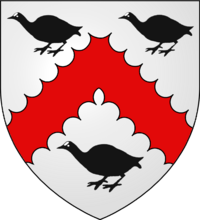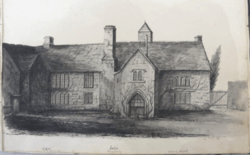Southcott family facts for kids
Quick facts for kids SouthcottSouthcote
|
|
|---|---|
| Minor nobility and Landed Gentry family | |

Coat of arms of the Southcott Family.
Argent, a chevron engrailed gules between three coots sable |
|
| Founded | 1243 |
| Founder | Michael de Southcott of Southcott |
| Titles | Baronets, Knights, Esquires, Manorial Lords and Gentlemen |
| Motto |
Nerth Dre Lelder
(Cornish: Strength Through Loyalty) |
| Estate(s) | |
The Southcott family is an old and important family from the English counties of Devon and Cornwall. Their name is also a surname that many people still have today.
Contents
History
The Southcott family name first appeared in the 13th century. The first person recorded with this name was Michael de Suthcot, who was the Lord of Suthcot. Later, in the 15th century, Sir Nicholas Southcott Jr. (1450–1512) was also recorded.
According to an old book called Survey of Devon by Tristram Risdon, Michael de Southcott was the start of a "great kindred" (a large family group) in the area. Michael originally came from Bodmin moor. He received the Southcott estate from the Oliver De Chambernon family in 1242. This family had been given the estate after the Norman conquest of England.
Key Family Members
Sir Nicholas Southcott's son, John Southcott (1481–1556), was an important figure. In 1544, after the Dissolution of the Monasteries (when King Henry VIII closed down many religious houses), John was given a place called Indio. He worked for Thomas Cromwell, a powerful advisor to the King. This helped him get several properties that used to belong to monasteries in Devon.
John Southcott also became the Clerk of the Peace for Devon. This was an important legal job. In 1547, he was chosen to be a MP for Lostwithiel. This made him a well-known politician in Cornwall.
During the time of King Edward VI, there were big changes to religion in England, known as the English Reformation. John Southcott supported the Prayer Book Rebellion in Cornwall and Devon. This rebellion was against the new religious rules. Even though the rebellion was stopped by the King's army, John Southcott was not punished. He was given a pardon and continued to be an MP.
Sir Nicholas's second son, William Southcott (born 1485), had a son named John (1510–1585). This John became a senior English judge and politician. He later became the Lord of the Manor of Witham in Essex. He was known for being a strong Catholic. He even gave up his job rather than publicly speak against a Catholic priest.
Another person from the Southcott family was Captain Philip Southcote (1698–1758). He married Anne Fitzroy, who was the Duchess of Southampton.
The Southcotts in the Civil War
During the English Civil War, which was a big fight between the King and Parliament, Captain Thomas Southcote was an important officer for the Royalists (those who supported the King) in Cornwall. He was the commander of the army base at Calstock. His group had about 1,200 Cornish soldiers.
In the war, the Parliamentarians (those who supported Parliament) attacked Gunnislake New Bridge. Captain Southcote and Sir Richard Grenville defended the bridge with their soldiers. Even though they lost 240 men and the bridge was taken, the Parliamentarian forces could not go further into Cornwall.
Lords of the Manor of Southcott
This is a list of some of the Southcott family members who were "Lords of the Manor" of Southcott. This meant they owned the land and had special rights in the area.
- Michael Southcot (born around 1202)
- William Southcott (born around 1233)
- Michael Southcott (born around 1258)
- William Southcott
- Michael Southcotte (born around 1325)
- William Southcote (born around 1360)
- William Southcote (born around 1390)
- Nicholas Southcote (born around 1419)
- Sir Nicholas Southcott (1450–1512)
- Thomas Southcot (born around 1483)
- John Southcott (born around 1510)
- John Southcot
- Phillip Southcott (1527–1587)
Lords of the Manor of Bovey Tracey

Here are some Southcott family members who were Lords of the Manor of Bovey Tracey:
- John Southcote (1481–1556)
- Thomas Southcote (1528–1600)
- George Southcot (born 1560)
- Thomas Southcote (died 1678)
- Sir Popham Southcote (1603–1643)
Lords of the Manor of Mohuns Ottery
These Southcott family members were Lords of the Manor of Mohuns Ottery:
- Thomas Southcote (1528–1600)
- George Southcot (born 1560)
- Thomas Southcote (died 1678)
- Sir Popham Southcote (1603–1643)
Lords of Blyborough and Baronets
The Southcott family also held lands in Blyborough and some members became Baronets. A Baronet is a special title, like a knight, that can be passed down through the family.
- Sir George Southcote (1572–1638)
- George Southcote
- Thomas Southcote (1622–1664)
- Sir George Southcote, 1st Baronet of Blyborough (1629–1663)
- Sir George Southcote, 2nd Baronet and Governor of Dartmouth Castle (1664–1691)
Southcote Baronets family chart
| Sir George Southcott MP of Blyborough, Shillingford, Stoke Fleming and Withycombe (1572-1638) |
|||||||||||||||||||||||||||||||||||||||||||||||
| Robert Southcote of Shillingford |
George Southcote of Stoke Fleming and Blyborough |
Capt. Thomas Southcott of Withycombe (1608-1657) |
Judith | Mary | Rebecca | ||||||||||||||||||||||||||||||||||||||||||
| Thomas Southcote MP DL JP of Stoke Fleming and Blyborough (c1622-1664) |
Sir George Southcote Bt 1st Baronet of Bliborough Created 1662 (1629-1663) |
Lady Catherine Southcote (Née Eliot) |
|||||||||||||||||||||||||||||||||||||||||||||
| Sir William Portman Bt KB MP FRS 6th Baronet of Orchard Portman (1664-1690) |
Lady Elizabeth Portman | Sir George Southcote Bt 2nd Baronet of Bliborough (1664-1698) |
Lady Mary Southcote (Née Smythe) |
Katherine Palmer | |||||||||||||||||||||||||||||||||||||||||||
| Katherine Smith | Constantine Fitzherbert | ||||||||||||||||||||||||||||||||||||||||||||||
Notable People
Captain Thomas Southcot
Captain Thomas Southcot (1608–1657) was an important officer in the Royalist Army during the English Civil War. He was the son of Sir George Southcott (1572–1638).
In 1644, he was the commander of the Royalist army base at Calstock and Cotehele. His soldiers were part of Sir Richard Grenville's army, which was protecting the Cornish side of the Tamar Valley. Captain Southcot helped defend Cornwall from the Parliamentarian forces led by Robert Devereux, 3rd Earl of Essex.
After a battle, an island that the Royalists defended was named Southcott Island to honor Captain Southcot.
Thomas Southcot passed away in 1657. He did not live to see the monarchy (the King) restored in 1661. However, King Charles II recognized Thomas's strong loyalty. He awarded Thomas's only son, George Southcote (1629–1663), with the title of Baronet of Bliborough.
Members of Parliament
Many Southcott family members became MPs, meaning they were chosen to represent their area in the English Parliament.
- John Southcote (around 1481-1556) was an MP for Lostwithiel. He was also the Clerk of the Peace of Devon.
- Sir John Southcote (1510–1585) was an MP for Lewes and later Steyning.
- Thomas Southcote (1528–1600) was an MP for Tavistock, then Plympton Erle, and later Dartmouth. He also held the important role of High Sheriff of Devon.
- George Southcote (1533–1589) was an MP for Lostwithiel and later Tavistock.
- Richard Southcote (1570–1594) was an MP for Plympton Erle.
- Sir George Southcote (1572–1638) was an MP for Plympton Erle. He was also a High Sheriff of Devon.
- Thomas Southcote (1622–1664) was an MP for Dartmouth. He was also a Deputy lieutenant of Devon.
High Sheriff
The High Sheriff was a very important official in a county, responsible for law and order.
- Thomas Southcote (1528–1600) was appointed Sheriff of Devon in 1558 and again in 1570.
- Sir George Southcote (1572–1638) was appointed Sheriff of Devon in 1616.
- George Southcott was appointed Sheriff of Devon in 1652.
- John Henry Southcote was appointed High Sheriff of Devon in 1785.

